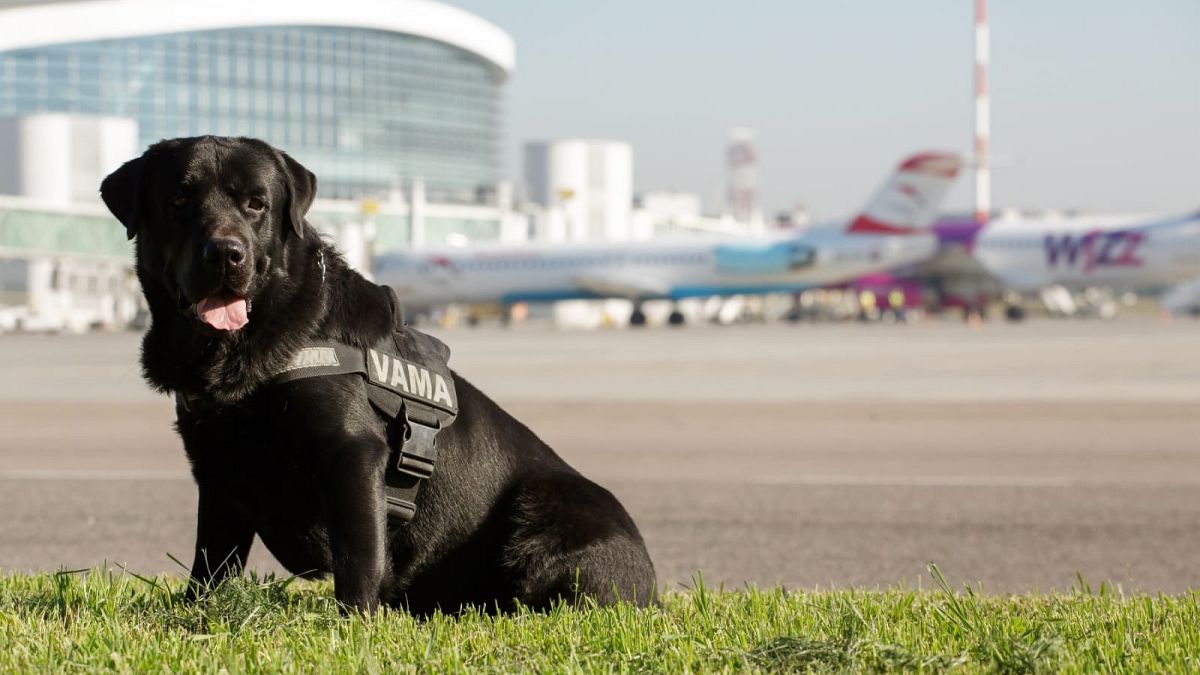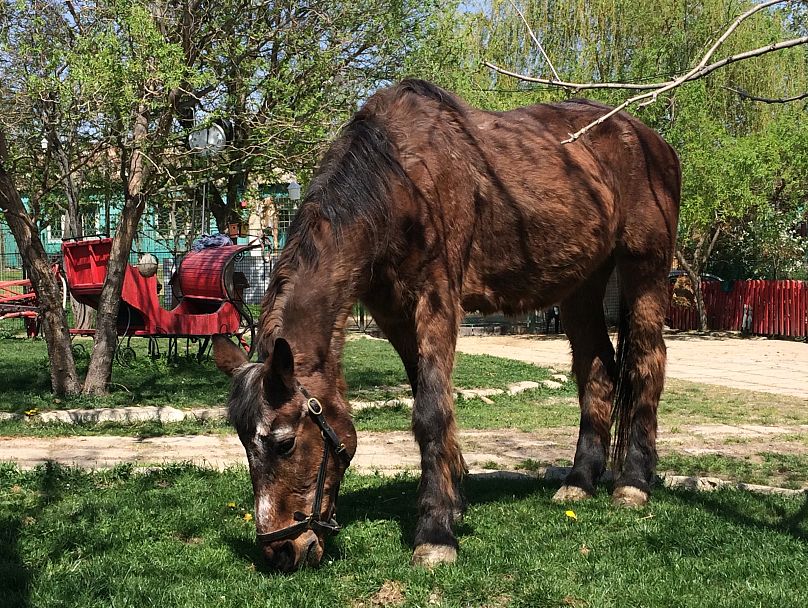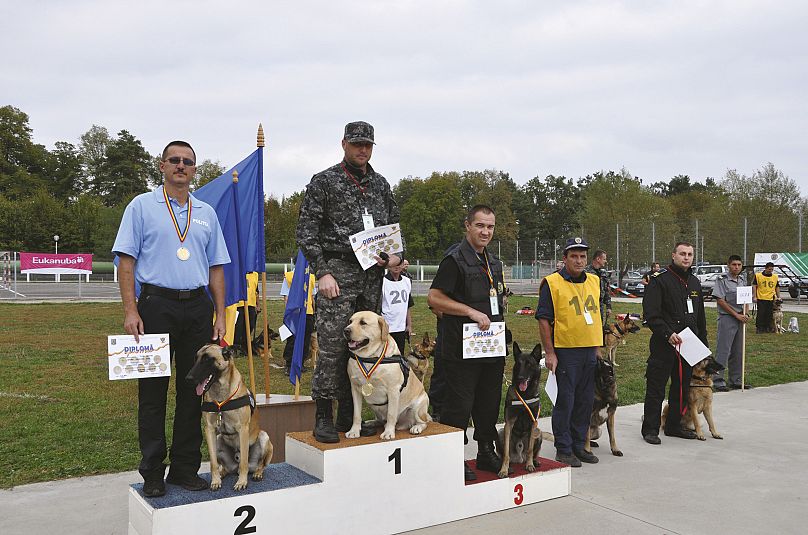They sniff out drug smugglers, patrol the streets, and carry out crowd control in the line of duty. But what happens when it’s time to retire?
Vina is grazing in a big yard looking to find the grassiest spots. The brown horse is old and her fur is no longer shimmering as it once was. In her Hay Day she used to turn heads on the streets, while she was out on patrol working for the Romanian Gendarmerie.
Almost three years ago, she was sent into retirement, which, for Vina, meant a shelter in Bucharest run by the NGO Steaua Sperantei Foundation. She arrived with another two four-legged colleagues from the Gendarmerie that had to retire as well. They already died two years ago.
“She is 28 years old and she is very friendly,” says Radu Sandoi, the shelter’s administrator. “People are not allowed to ride these horses. Children are happy to caress them and give them sugar.”
There is no standardised process in place for what happens to animals like Vina once they retire in Romania. Each public institution using dogs and horses has its own internal rules regarding the age of retirement, the money allocated, and the procedure of what happens with them when they cannot work anymore. A new law proposal wants to introduce obligatory veterinary care for retired animals of up to 300 RON (€64) each month.
“We think it is a good law proposal, on the condition that it also provides shelters for these animals. Retired horses can’t work, so it is hard to find adopters for them. Those with houses in rural areas, they don’t adopt horses as pets,” said Sandoi.
According to Georgian Enache, a spokesperson for the Bucharest Gendarmerie, once police horses and dogs retire, staff that worked with them can take them, or they are donated to NGOs or another authority that still has use for them.
A horse can work for 13 and a half years and a dog for seven years. After this period, they can still remain in service but they need a veterinary certificate each year.
“Until they retire, they still receive something. After that, nobody cares, although the animal served the country, so to speak,” said Gigi Oleniuc, a chief-agent at the Romanian Border Police who adopted Liz, a 10-year-old Labrador retriever he worked with.
Oleniuc bought the dog when he was six weeks old. He already had his hopes set on making him his partner at the border police in Siret, on the northern border to Ukraine. So he donated him to his employer and signed them both up for the four-months training necessary for the role.
“My aim was to prove that we can achieve good results on the ground too, not only at the training centre.” In 2012, Liz won first place for drug detection at an international contest organised by the ministry of interior.
In 2017, Liz was one of four border police dogs to retire. All of them were taken in by the officers they worked with. “With all the difficulties and all the risks, I couldn’t give up on him. He was my right hand, always on the right seat in my car,” Oleniuc said.
The border police have special shelters for the dogs throughout their working lives. But if the officers working with them want to, they can take the dogs home just as Oleniuc did – though his wife was less pleased about the new addition to the family.
“The kids were happy. My wife got used to it. At the beginning, she was afraid." Car seating arrangements had to be changed with Oleniuc's wife literally taking a back seat. "Eventually she accepted that she must sit in the back, because the dog always sits in front,” he said.
When Liz was working, Oleniuc received 21 kilos of dog food each month and a 5% salary increase that meant an extra 60 RON (€13) a month.
At the end of 2017, there were 336 dogs working for the Border Police. Throughout the year, the dogs sniffed out over 75,000 cigarette packs, 1075 Ecstasy tablets, 3240 tablets and 167 ampoules of anabolic substances, as well as people being smuggled across state borders, according to Alexandra Popescu, a spokeswoman for the border police. Six teams with dogs also participated in operations by the European border and coast guard authority Frontex.
General Directorate of Customs in Romania is another institution which uses dogs. There the animals are trained to do several tasks while the ones used by the border police units specialise in one. “The dogs working for customs are two in one,” said Alexandru Ionita, the man in charge of the canine team. “We have animals specialised in detecting both drugs and cigarettes. And three years ago we started training them to detect money as well.”
For that, the custom’s officers and their dogs have to train for a total of 15 weeks split into two stages. “The drug detection dogs, for instance, in the first stage learn to seek, and to listen to their master’s order. It is a disciplinary training. They memorise the smells of natural drugs - marijuana, hashish. In the second stage, they memorise the smells of heroin, amphetamine, and ecstasy,” said Ionita.
For 2017, the work of the canine teams led to 462 sanctions with fines grossing more than 350,000 euros.
Following the example of the French and German customs authority’s canine teams, the dogs live with the officers they work with while they are still in action as it creates a stronger bond.
Phil, Ionita’s first dog, also lived with him and his family. When the time came for the dog to retire, Ionita adopted him. “It was a Labrador specialised in drug detection, trained at the French customs. He worked until the age of nine to 10 and he lived until he was 14. Each year, he detected at least one or two drug hauls. For four years after the end of his service, he was my family dog. He stayed in my house for a while and even lived with my new work dog.”
Unlike other institutions, according to internal regulations, the General Directorate of Customs reimburses the veterinary costs for retired dogs, when presented with the receipts by the employees who adopted them.
In 2017, 12 dogs received a pension from the customs authority and another 40 are currently working.
According to the senator who drafted the new law on animal pensions, each year there are approximately 100 dogs and horses that retire across all the different institutions. He estimates that the total expenditure on veterinary care would be less than €80,000 per year.


